Report: Associations between Job Insecurity and Employee Well-being
VerifiedAdded on 2020/07/22
|8
|2462
|33
Report
AI Summary
This report examines the associations between quantitative and qualitative job insecurity and employee well-being within the context of Belgian banks. The research involved a sample of 15,000 employees, representing 21% of the total workforce across 63 banks. The study utilizes simple random sampling to select participants and explores the measures of variables such as gender, age, educational level, and income to correlate with job satisfaction and psychological distress. The research design incorporates explanatory, exploratory, and descriptive techniques to analyze data and ascertain the impact of job insecurity on employee well-being. Data collection focuses on social demographics, including gender, age, and education, to classify findings effectively and improve the robustness of the research.

Associations between Quantitative and
Qualitative Job Insecurity and Well-Being
Qualitative Job Insecurity and Well-Being
Paraphrase This Document
Need a fresh take? Get an instant paraphrase of this document with our AI Paraphraser
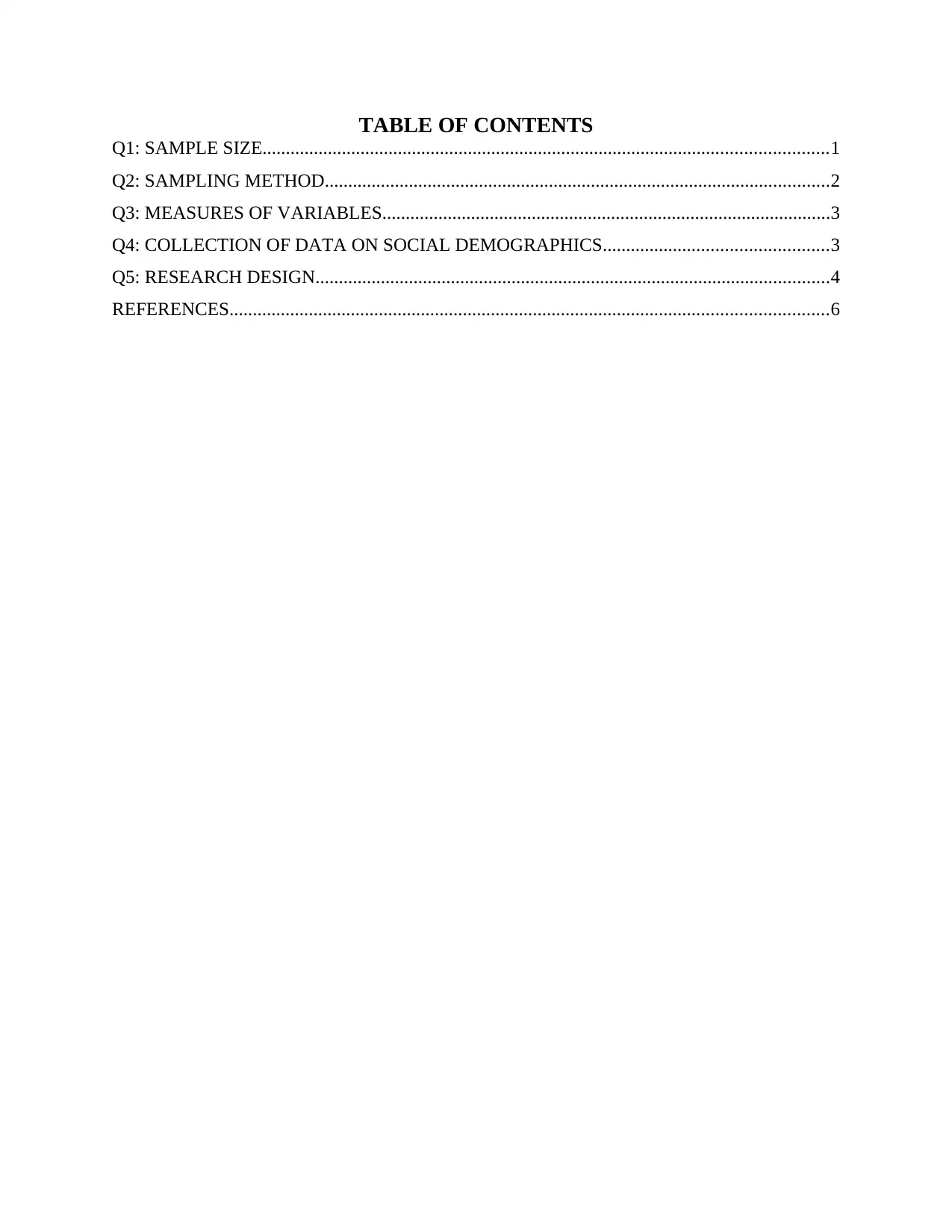
TABLE OF CONTENTS
Q1: SAMPLE SIZE.........................................................................................................................1
Q2: SAMPLING METHOD............................................................................................................2
Q3: MEASURES OF VARIABLES................................................................................................3
Q4: COLLECTION OF DATA ON SOCIAL DEMOGRAPHICS................................................3
Q5: RESEARCH DESIGN..............................................................................................................4
REFERENCES................................................................................................................................6
Q1: SAMPLE SIZE.........................................................................................................................1
Q2: SAMPLING METHOD............................................................................................................2
Q3: MEASURES OF VARIABLES................................................................................................3
Q4: COLLECTION OF DATA ON SOCIAL DEMOGRAPHICS................................................3
Q5: RESEARCH DESIGN..............................................................................................................4
REFERENCES................................................................................................................................6
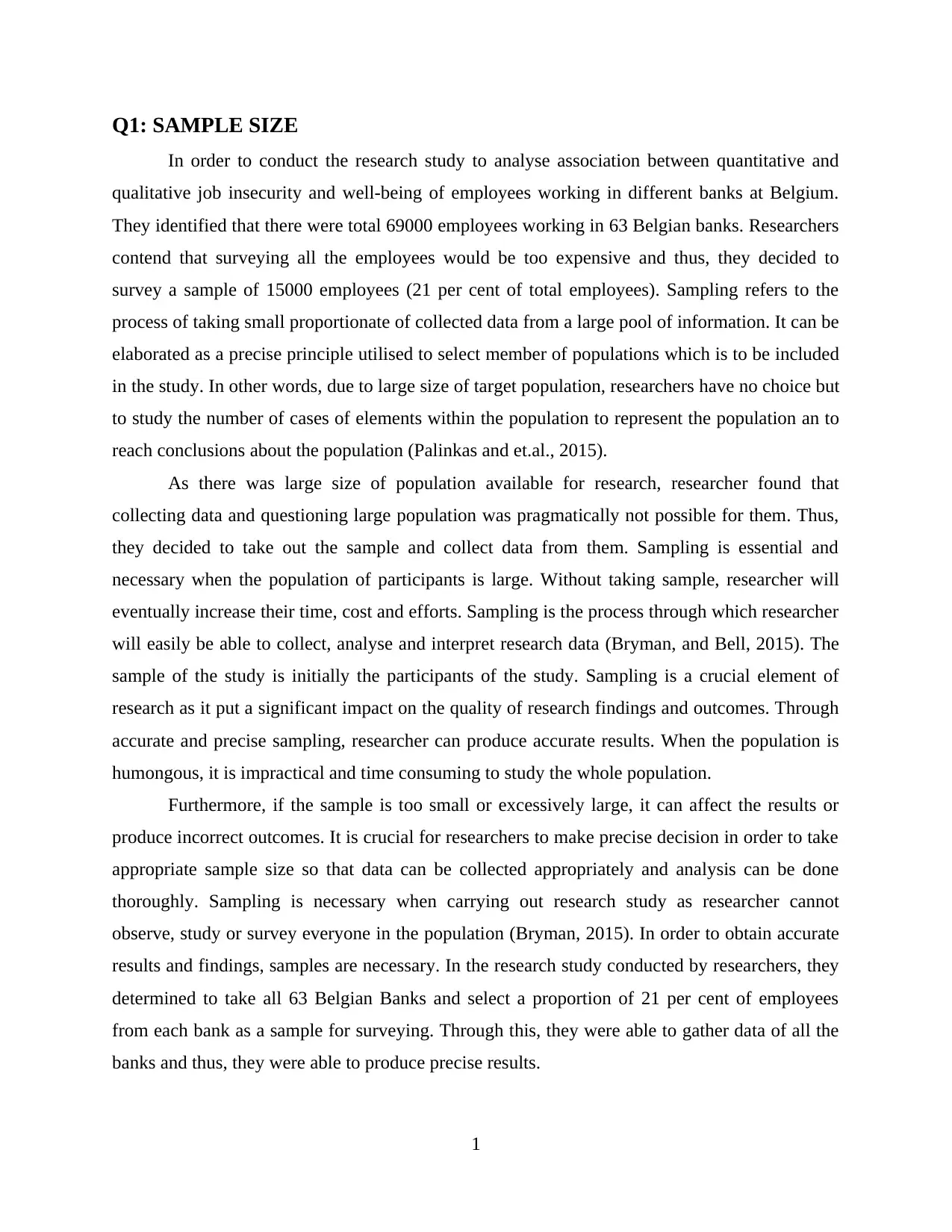
Q1: SAMPLE SIZE
In order to conduct the research study to analyse association between quantitative and
qualitative job insecurity and well-being of employees working in different banks at Belgium.
They identified that there were total 69000 employees working in 63 Belgian banks. Researchers
contend that surveying all the employees would be too expensive and thus, they decided to
survey a sample of 15000 employees (21 per cent of total employees). Sampling refers to the
process of taking small proportionate of collected data from a large pool of information. It can be
elaborated as a precise principle utilised to select member of populations which is to be included
in the study. In other words, due to large size of target population, researchers have no choice but
to study the number of cases of elements within the population to represent the population an to
reach conclusions about the population (Palinkas and et.al., 2015).
As there was large size of population available for research, researcher found that
collecting data and questioning large population was pragmatically not possible for them. Thus,
they decided to take out the sample and collect data from them. Sampling is essential and
necessary when the population of participants is large. Without taking sample, researcher will
eventually increase their time, cost and efforts. Sampling is the process through which researcher
will easily be able to collect, analyse and interpret research data (Bryman, and Bell, 2015). The
sample of the study is initially the participants of the study. Sampling is a crucial element of
research as it put a significant impact on the quality of research findings and outcomes. Through
accurate and precise sampling, researcher can produce accurate results. When the population is
humongous, it is impractical and time consuming to study the whole population.
Furthermore, if the sample is too small or excessively large, it can affect the results or
produce incorrect outcomes. It is crucial for researchers to make precise decision in order to take
appropriate sample size so that data can be collected appropriately and analysis can be done
thoroughly. Sampling is necessary when carrying out research study as researcher cannot
observe, study or survey everyone in the population (Bryman, 2015). In order to obtain accurate
results and findings, samples are necessary. In the research study conducted by researchers, they
determined to take all 63 Belgian Banks and select a proportion of 21 per cent of employees
from each bank as a sample for surveying. Through this, they were able to gather data of all the
banks and thus, they were able to produce precise results.
1
In order to conduct the research study to analyse association between quantitative and
qualitative job insecurity and well-being of employees working in different banks at Belgium.
They identified that there were total 69000 employees working in 63 Belgian banks. Researchers
contend that surveying all the employees would be too expensive and thus, they decided to
survey a sample of 15000 employees (21 per cent of total employees). Sampling refers to the
process of taking small proportionate of collected data from a large pool of information. It can be
elaborated as a precise principle utilised to select member of populations which is to be included
in the study. In other words, due to large size of target population, researchers have no choice but
to study the number of cases of elements within the population to represent the population an to
reach conclusions about the population (Palinkas and et.al., 2015).
As there was large size of population available for research, researcher found that
collecting data and questioning large population was pragmatically not possible for them. Thus,
they decided to take out the sample and collect data from them. Sampling is essential and
necessary when the population of participants is large. Without taking sample, researcher will
eventually increase their time, cost and efforts. Sampling is the process through which researcher
will easily be able to collect, analyse and interpret research data (Bryman, and Bell, 2015). The
sample of the study is initially the participants of the study. Sampling is a crucial element of
research as it put a significant impact on the quality of research findings and outcomes. Through
accurate and precise sampling, researcher can produce accurate results. When the population is
humongous, it is impractical and time consuming to study the whole population.
Furthermore, if the sample is too small or excessively large, it can affect the results or
produce incorrect outcomes. It is crucial for researchers to make precise decision in order to take
appropriate sample size so that data can be collected appropriately and analysis can be done
thoroughly. Sampling is necessary when carrying out research study as researcher cannot
observe, study or survey everyone in the population (Bryman, 2015). In order to obtain accurate
results and findings, samples are necessary. In the research study conducted by researchers, they
determined to take all 63 Belgian Banks and select a proportion of 21 per cent of employees
from each bank as a sample for surveying. Through this, they were able to gather data of all the
banks and thus, they were able to produce precise results.
1
⊘ This is a preview!⊘
Do you want full access?
Subscribe today to unlock all pages.

Trusted by 1+ million students worldwide

Q2: SAMPLING METHOD
In the research of association between quantitative and qualitative job insecurity and
well-being, researcher has used simple random sampling method to select the participants of the
study. Simple random sampling is also known as random sampling is the purest and most
straightforward probability sampling strategy (Fraley and Hudson, 2014). It is also renowned
approach for selecting a sample among population for a broad range of purposes. In simple
random sampling each participant of the population is likely to be selected as a part of sample. In
simple terms simple random sampling refers to the sampling procedures that ensures that each
element in the population will have an equal chance of being included in the sample (Sekaran
and Bougie, 2016). Simple random sampling method helps researchers in reducing their efforts
in selecting sample size and researchers required minimum knowledge about the participant of
the study. In this context, the advantages and disadvantages of simple random sampling are
described as below:
Advantages
Minimal knowledge of population needed: The key benefit of using simple random sampling is
that it researcher required minimal knowledge of population (Bernard, 2017). In the study,
researcher randomly selected the participants of the study irrespective of their position, gender,
experience, etc.
Easy to analyse data: Through simple random sampling, researcher has to select the participants
randomly and analyse data accordingly. It becomes easy for the researcher to analyse collected
data and information. Researcher has to put minimum efforts in order to select the participants of
study and thus, process of analysis will become easy and efficient.
Beneficial for analysing large population: Simple random sampling method is beneficial for
analysing larger population (Gentles and et.al., 2015). Researcher has to take the sample
appropriately and accurately so that effectiveness in outcomes of research can be enhanced.
Disadvantages
Low frequency of use: The drawback of simple random sampling is that it is not frequently used
by researchers. It can only be used with quantitative studies and researcher has to select the
sample appropriately so that effectual findings of research can be produced (Moser and Kalton,
2017). Inappropriate selection of sample might degrade the quality of research and put direct
impact on outcomes negatively.
2
In the research of association between quantitative and qualitative job insecurity and
well-being, researcher has used simple random sampling method to select the participants of the
study. Simple random sampling is also known as random sampling is the purest and most
straightforward probability sampling strategy (Fraley and Hudson, 2014). It is also renowned
approach for selecting a sample among population for a broad range of purposes. In simple
random sampling each participant of the population is likely to be selected as a part of sample. In
simple terms simple random sampling refers to the sampling procedures that ensures that each
element in the population will have an equal chance of being included in the sample (Sekaran
and Bougie, 2016). Simple random sampling method helps researchers in reducing their efforts
in selecting sample size and researchers required minimum knowledge about the participant of
the study. In this context, the advantages and disadvantages of simple random sampling are
described as below:
Advantages
Minimal knowledge of population needed: The key benefit of using simple random sampling is
that it researcher required minimal knowledge of population (Bernard, 2017). In the study,
researcher randomly selected the participants of the study irrespective of their position, gender,
experience, etc.
Easy to analyse data: Through simple random sampling, researcher has to select the participants
randomly and analyse data accordingly. It becomes easy for the researcher to analyse collected
data and information. Researcher has to put minimum efforts in order to select the participants of
study and thus, process of analysis will become easy and efficient.
Beneficial for analysing large population: Simple random sampling method is beneficial for
analysing larger population (Gentles and et.al., 2015). Researcher has to take the sample
appropriately and accurately so that effectiveness in outcomes of research can be enhanced.
Disadvantages
Low frequency of use: The drawback of simple random sampling is that it is not frequently used
by researchers. It can only be used with quantitative studies and researcher has to select the
sample appropriately so that effectual findings of research can be produced (Moser and Kalton,
2017). Inappropriate selection of sample might degrade the quality of research and put direct
impact on outcomes negatively.
2
Paraphrase This Document
Need a fresh take? Get an instant paraphrase of this document with our AI Paraphraser
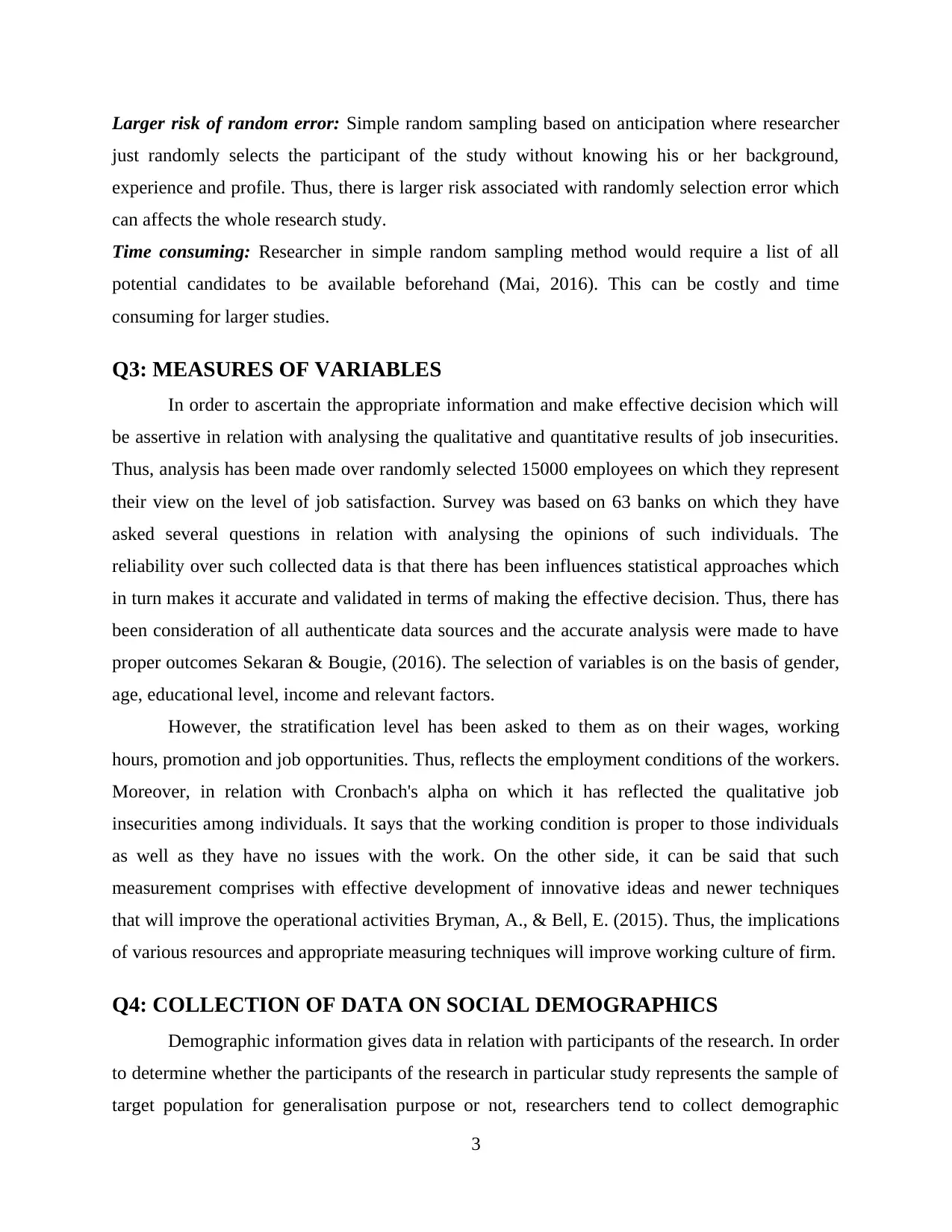
Larger risk of random error: Simple random sampling based on anticipation where researcher
just randomly selects the participant of the study without knowing his or her background,
experience and profile. Thus, there is larger risk associated with randomly selection error which
can affects the whole research study.
Time consuming: Researcher in simple random sampling method would require a list of all
potential candidates to be available beforehand (Mai, 2016). This can be costly and time
consuming for larger studies.
Q3: MEASURES OF VARIABLES
In order to ascertain the appropriate information and make effective decision which will
be assertive in relation with analysing the qualitative and quantitative results of job insecurities.
Thus, analysis has been made over randomly selected 15000 employees on which they represent
their view on the level of job satisfaction. Survey was based on 63 banks on which they have
asked several questions in relation with analysing the opinions of such individuals. The
reliability over such collected data is that there has been influences statistical approaches which
in turn makes it accurate and validated in terms of making the effective decision. Thus, there has
been consideration of all authenticate data sources and the accurate analysis were made to have
proper outcomes Sekaran & Bougie, (2016). The selection of variables is on the basis of gender,
age, educational level, income and relevant factors.
However, the stratification level has been asked to them as on their wages, working
hours, promotion and job opportunities. Thus, reflects the employment conditions of the workers.
Moreover, in relation with Cronbach's alpha on which it has reflected the qualitative job
insecurities among individuals. It says that the working condition is proper to those individuals
as well as they have no issues with the work. On the other side, it can be said that such
measurement comprises with effective development of innovative ideas and newer techniques
that will improve the operational activities Bryman, A., & Bell, E. (2015). Thus, the implications
of various resources and appropriate measuring techniques will improve working culture of firm.
Q4: COLLECTION OF DATA ON SOCIAL DEMOGRAPHICS
Demographic information gives data in relation with participants of the research. In order
to determine whether the participants of the research in particular study represents the sample of
target population for generalisation purpose or not, researchers tend to collect demographic
3
just randomly selects the participant of the study without knowing his or her background,
experience and profile. Thus, there is larger risk associated with randomly selection error which
can affects the whole research study.
Time consuming: Researcher in simple random sampling method would require a list of all
potential candidates to be available beforehand (Mai, 2016). This can be costly and time
consuming for larger studies.
Q3: MEASURES OF VARIABLES
In order to ascertain the appropriate information and make effective decision which will
be assertive in relation with analysing the qualitative and quantitative results of job insecurities.
Thus, analysis has been made over randomly selected 15000 employees on which they represent
their view on the level of job satisfaction. Survey was based on 63 banks on which they have
asked several questions in relation with analysing the opinions of such individuals. The
reliability over such collected data is that there has been influences statistical approaches which
in turn makes it accurate and validated in terms of making the effective decision. Thus, there has
been consideration of all authenticate data sources and the accurate analysis were made to have
proper outcomes Sekaran & Bougie, (2016). The selection of variables is on the basis of gender,
age, educational level, income and relevant factors.
However, the stratification level has been asked to them as on their wages, working
hours, promotion and job opportunities. Thus, reflects the employment conditions of the workers.
Moreover, in relation with Cronbach's alpha on which it has reflected the qualitative job
insecurities among individuals. It says that the working condition is proper to those individuals
as well as they have no issues with the work. On the other side, it can be said that such
measurement comprises with effective development of innovative ideas and newer techniques
that will improve the operational activities Bryman, A., & Bell, E. (2015). Thus, the implications
of various resources and appropriate measuring techniques will improve working culture of firm.
Q4: COLLECTION OF DATA ON SOCIAL DEMOGRAPHICS
Demographic information gives data in relation with participants of the research. In order
to determine whether the participants of the research in particular study represents the sample of
target population for generalisation purpose or not, researchers tend to collect demographic
3
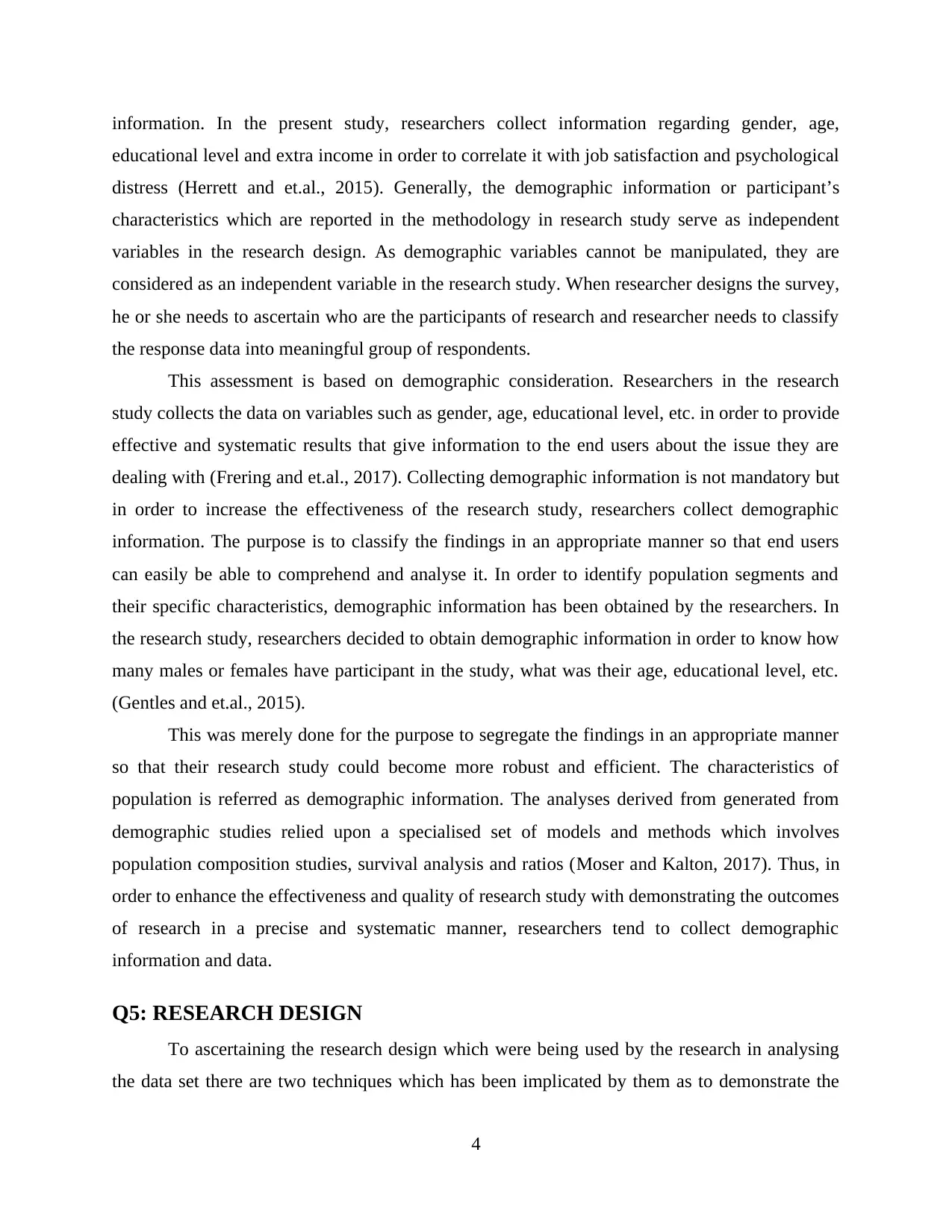
information. In the present study, researchers collect information regarding gender, age,
educational level and extra income in order to correlate it with job satisfaction and psychological
distress (Herrett and et.al., 2015). Generally, the demographic information or participant’s
characteristics which are reported in the methodology in research study serve as independent
variables in the research design. As demographic variables cannot be manipulated, they are
considered as an independent variable in the research study. When researcher designs the survey,
he or she needs to ascertain who are the participants of research and researcher needs to classify
the response data into meaningful group of respondents.
This assessment is based on demographic consideration. Researchers in the research
study collects the data on variables such as gender, age, educational level, etc. in order to provide
effective and systematic results that give information to the end users about the issue they are
dealing with (Frering and et.al., 2017). Collecting demographic information is not mandatory but
in order to increase the effectiveness of the research study, researchers collect demographic
information. The purpose is to classify the findings in an appropriate manner so that end users
can easily be able to comprehend and analyse it. In order to identify population segments and
their specific characteristics, demographic information has been obtained by the researchers. In
the research study, researchers decided to obtain demographic information in order to know how
many males or females have participant in the study, what was their age, educational level, etc.
(Gentles and et.al., 2015).
This was merely done for the purpose to segregate the findings in an appropriate manner
so that their research study could become more robust and efficient. The characteristics of
population is referred as demographic information. The analyses derived from generated from
demographic studies relied upon a specialised set of models and methods which involves
population composition studies, survival analysis and ratios (Moser and Kalton, 2017). Thus, in
order to enhance the effectiveness and quality of research study with demonstrating the outcomes
of research in a precise and systematic manner, researchers tend to collect demographic
information and data.
Q5: RESEARCH DESIGN
To ascertaining the research design which were being used by the research in analysing
the data set there are two techniques which has been implicated by them as to demonstrate the
4
educational level and extra income in order to correlate it with job satisfaction and psychological
distress (Herrett and et.al., 2015). Generally, the demographic information or participant’s
characteristics which are reported in the methodology in research study serve as independent
variables in the research design. As demographic variables cannot be manipulated, they are
considered as an independent variable in the research study. When researcher designs the survey,
he or she needs to ascertain who are the participants of research and researcher needs to classify
the response data into meaningful group of respondents.
This assessment is based on demographic consideration. Researchers in the research
study collects the data on variables such as gender, age, educational level, etc. in order to provide
effective and systematic results that give information to the end users about the issue they are
dealing with (Frering and et.al., 2017). Collecting demographic information is not mandatory but
in order to increase the effectiveness of the research study, researchers collect demographic
information. The purpose is to classify the findings in an appropriate manner so that end users
can easily be able to comprehend and analyse it. In order to identify population segments and
their specific characteristics, demographic information has been obtained by the researchers. In
the research study, researchers decided to obtain demographic information in order to know how
many males or females have participant in the study, what was their age, educational level, etc.
(Gentles and et.al., 2015).
This was merely done for the purpose to segregate the findings in an appropriate manner
so that their research study could become more robust and efficient. The characteristics of
population is referred as demographic information. The analyses derived from generated from
demographic studies relied upon a specialised set of models and methods which involves
population composition studies, survival analysis and ratios (Moser and Kalton, 2017). Thus, in
order to enhance the effectiveness and quality of research study with demonstrating the outcomes
of research in a precise and systematic manner, researchers tend to collect demographic
information and data.
Q5: RESEARCH DESIGN
To ascertaining the research design which were being used by the research in analysing
the data set there are two techniques which has been implicated by them as to demonstrate the
4
⊘ This is a preview!⊘
Do you want full access?
Subscribe today to unlock all pages.

Trusted by 1+ million students worldwide

employee behaviour. It consists of collecting, analysing and determining the data to have
accurate analysis. It comprises with the effective description and data analysis which in turn is
helpful to have accurate details relevant with job satisfaction among employees. There are
several designs which will be helpful in conducting the effective research.
Explanatory
This is the technique which will be effective as per analysing predicted research
problems. It will connect to newer ideas and approaches which in turn develop the appropriate
outcomes. It comprises when the research has enough information and knowledge regrading
areas of research. Thus, the implication of careful testing and relevant theories, methods which
will be helpful in determining the causes and effects over such outcomes (Organizing Your
Social Sciences Research Paper: Types of Research Designs, 2017).
Exploratory
In this technique or method where the research will be based on analysing and identifying
the enough knowledge relevant with the research Herrett & et.al, (2015). Therefore, here the data
and information will be collected and analysed to have clarified details about research problem.
It is a technique which will be helpful in generating the new ideas as well as developing it to
have effective solution to such issues.
Descriptive
This is the technique which comprises of making effective analysis over the data set and
collected information Bryman, A., & Bell, E. (2015). Moreover, it will be helpful in having the
proper analysis onbasis of statistical measurements such as mean, mode, median, etc. The motive
behind implicating such techniques is to have the most adequate and appropriate determination
of the outcomes that will be helpful in decision making as well as resolving the issues.
5
accurate analysis. It comprises with the effective description and data analysis which in turn is
helpful to have accurate details relevant with job satisfaction among employees. There are
several designs which will be helpful in conducting the effective research.
Explanatory
This is the technique which will be effective as per analysing predicted research
problems. It will connect to newer ideas and approaches which in turn develop the appropriate
outcomes. It comprises when the research has enough information and knowledge regrading
areas of research. Thus, the implication of careful testing and relevant theories, methods which
will be helpful in determining the causes and effects over such outcomes (Organizing Your
Social Sciences Research Paper: Types of Research Designs, 2017).
Exploratory
In this technique or method where the research will be based on analysing and identifying
the enough knowledge relevant with the research Herrett & et.al, (2015). Therefore, here the data
and information will be collected and analysed to have clarified details about research problem.
It is a technique which will be helpful in generating the new ideas as well as developing it to
have effective solution to such issues.
Descriptive
This is the technique which comprises of making effective analysis over the data set and
collected information Bryman, A., & Bell, E. (2015). Moreover, it will be helpful in having the
proper analysis onbasis of statistical measurements such as mean, mode, median, etc. The motive
behind implicating such techniques is to have the most adequate and appropriate determination
of the outcomes that will be helpful in decision making as well as resolving the issues.
5
Paraphrase This Document
Need a fresh take? Get an instant paraphrase of this document with our AI Paraphraser
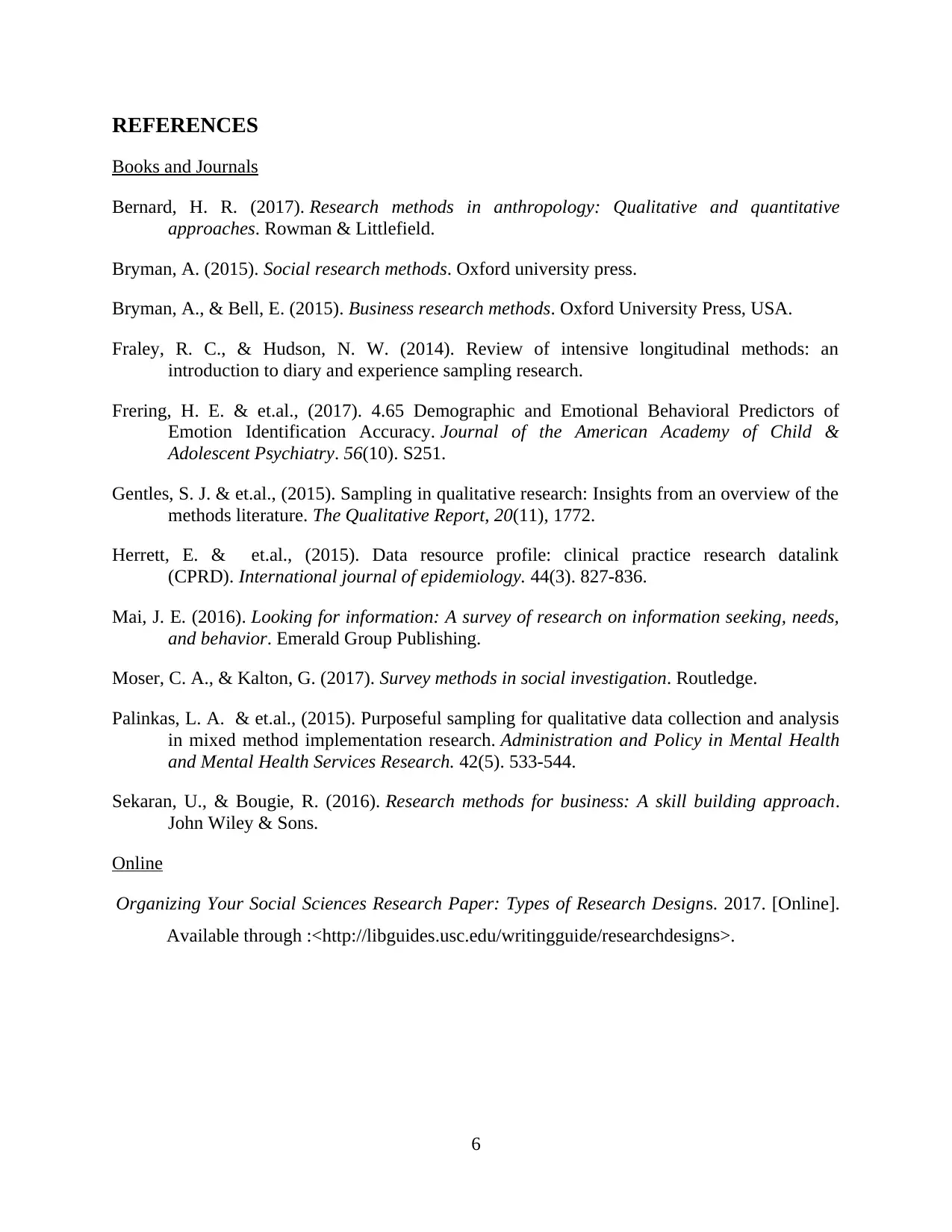
REFERENCES
Books and Journals
Bernard, H. R. (2017). Research methods in anthropology: Qualitative and quantitative
approaches. Rowman & Littlefield.
Bryman, A. (2015). Social research methods. Oxford university press.
Bryman, A., & Bell, E. (2015). Business research methods. Oxford University Press, USA.
Fraley, R. C., & Hudson, N. W. (2014). Review of intensive longitudinal methods: an
introduction to diary and experience sampling research.
Frering, H. E. & et.al., (2017). 4.65 Demographic and Emotional Behavioral Predictors of
Emotion Identification Accuracy. Journal of the American Academy of Child &
Adolescent Psychiatry. 56(10). S251.
Gentles, S. J. & et.al., (2015). Sampling in qualitative research: Insights from an overview of the
methods literature. The Qualitative Report, 20(11), 1772.
Herrett, E. & et.al., (2015). Data resource profile: clinical practice research datalink
(CPRD). International journal of epidemiology. 44(3). 827-836.
Mai, J. E. (2016). Looking for information: A survey of research on information seeking, needs,
and behavior. Emerald Group Publishing.
Moser, C. A., & Kalton, G. (2017). Survey methods in social investigation. Routledge.
Palinkas, L. A. & et.al., (2015). Purposeful sampling for qualitative data collection and analysis
in mixed method implementation research. Administration and Policy in Mental Health
and Mental Health Services Research. 42(5). 533-544.
Sekaran, U., & Bougie, R. (2016). Research methods for business: A skill building approach.
John Wiley & Sons.
Online
Organizing Your Social Sciences Research Paper: Types of Research Designs. 2017. [Online].
Available through :<http://libguides.usc.edu/writingguide/researchdesigns>.
6
Books and Journals
Bernard, H. R. (2017). Research methods in anthropology: Qualitative and quantitative
approaches. Rowman & Littlefield.
Bryman, A. (2015). Social research methods. Oxford university press.
Bryman, A., & Bell, E. (2015). Business research methods. Oxford University Press, USA.
Fraley, R. C., & Hudson, N. W. (2014). Review of intensive longitudinal methods: an
introduction to diary and experience sampling research.
Frering, H. E. & et.al., (2017). 4.65 Demographic and Emotional Behavioral Predictors of
Emotion Identification Accuracy. Journal of the American Academy of Child &
Adolescent Psychiatry. 56(10). S251.
Gentles, S. J. & et.al., (2015). Sampling in qualitative research: Insights from an overview of the
methods literature. The Qualitative Report, 20(11), 1772.
Herrett, E. & et.al., (2015). Data resource profile: clinical practice research datalink
(CPRD). International journal of epidemiology. 44(3). 827-836.
Mai, J. E. (2016). Looking for information: A survey of research on information seeking, needs,
and behavior. Emerald Group Publishing.
Moser, C. A., & Kalton, G. (2017). Survey methods in social investigation. Routledge.
Palinkas, L. A. & et.al., (2015). Purposeful sampling for qualitative data collection and analysis
in mixed method implementation research. Administration and Policy in Mental Health
and Mental Health Services Research. 42(5). 533-544.
Sekaran, U., & Bougie, R. (2016). Research methods for business: A skill building approach.
John Wiley & Sons.
Online
Organizing Your Social Sciences Research Paper: Types of Research Designs. 2017. [Online].
Available through :<http://libguides.usc.edu/writingguide/researchdesigns>.
6
1 out of 8
Related Documents
Your All-in-One AI-Powered Toolkit for Academic Success.
+13062052269
info@desklib.com
Available 24*7 on WhatsApp / Email
![[object Object]](/_next/static/media/star-bottom.7253800d.svg)
Unlock your academic potential
Copyright © 2020–2025 A2Z Services. All Rights Reserved. Developed and managed by ZUCOL.





